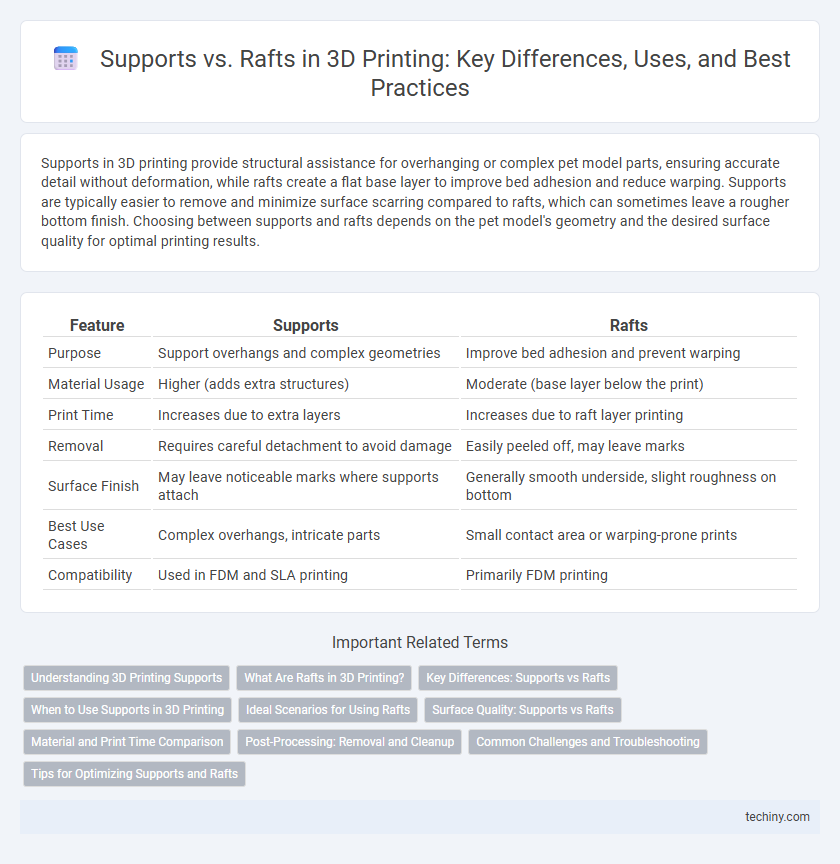Supports in 3D printing provide structural assistance for overhanging or complex pet model parts, ensuring accurate detail without deformation, while rafts create a flat base layer to improve bed adhesion and reduce warping. Supports are typically easier to remove and minimize surface scarring compared to rafts, which can sometimes leave a rougher bottom finish. Choosing between supports and rafts depends on the pet model's geometry and the desired surface quality for optimal printing results.
Table of Comparison
| Feature | Supports | Rafts |
|---|---|---|
| Purpose | Support overhangs and complex geometries | Improve bed adhesion and prevent warping |
| Material Usage | Higher (adds extra structures) | Moderate (base layer below the print) |
| Print Time | Increases due to extra layers | Increases due to raft layer printing |
| Removal | Requires careful detachment to avoid damage | Easily peeled off, may leave marks |
| Surface Finish | May leave noticeable marks where supports attach | Generally smooth underside, slight roughness on bottom |
| Best Use Cases | Complex overhangs, intricate parts | Small contact area or warping-prone prints |
| Compatibility | Used in FDM and SLA printing | Primarily FDM printing |
Understanding 3D Printing Supports
3D printing supports are essential structures that prevent overhangs and complex geometries from collapsing during the printing process by providing temporary stability. Unlike rafts, which create a base layer to improve bed adhesion, supports directly uphold specific sections of the model that cannot be printed in mid-air. Proper understanding and optimization of support settings improve print quality, reduce material waste, and simplify post-processing cleanup.
What Are Rafts in 3D Printing?
Rafts in 3D printing are flat, horizontal layers printed beneath the actual object to enhance bed adhesion and prevent warping during the printing process. Made from the same material as the print, rafts create a stable foundation that improves print stability on uneven or smooth build plates. Removing rafts is generally straightforward but requires careful post-processing to avoid surface imperfections on the finished model.
Key Differences: Supports vs Rafts
Supports are temporary structures that provide stability to overhanging or complex geometry during 3D printing, preventing sagging or collapse. Rafts are flat, grid-like bases printed beneath the model to enhance bed adhesion and improve first-layer stability, especially on uneven surfaces. While supports focus on preserving intricate details and overhangs, rafts primarily ensure overall model attachment to the print bed.
When to Use Supports in 3D Printing
Supports in 3D printing are essential when printing models with overhangs exceeding 45 degrees or complex geometries that cannot be printed layer-by-layer without collapse. They provide a temporary scaffold beneath unsupported sections, ensuring dimensional accuracy and surface quality by preventing sagging or warping during the printing process. Choosing supports over rafts is ideal when structural integrity and fine detail preservation are critical for parts with intricate designs or steep angles.
Ideal Scenarios for Using Rafts
Rafts are ideal for 3D prints requiring enhanced bed adhesion, especially when printing with materials prone to warping such as ABS or nylon. They provide a stable foundation for models with small footprints or uneven bottoms, preventing lifting and ensuring dimensional accuracy. Using rafts is also beneficial when the build plate surface is irregular or poorly calibrated, as they compensate for minor imperfections.
Surface Quality: Supports vs Rafts
Supports in 3D printing provide structural stability for overhangs but often leave marks on the surface where they attach, potentially requiring post-processing to improve surface quality. Rafts create a stable base layer that enhances adhesion to the build platform without directly impacting the main object's surface finish, resulting in smoother bottom layers. Choosing between supports and rafts depends on balancing the need for structural integrity against desired surface smoothness and ease of cleanup.
Material and Print Time Comparison
Supports require less additional material than rafts, as they are designed to hold overhangs without covering the entire print base, resulting in reduced filament usage. Rafts consume more material because they create a full base layer beneath the object, which increases weight and cost. Print time is shorter with supports since they use less material and require less removal time compared to rafts that add extra layers and post-processing effort.
Post-Processing: Removal and Cleanup
Support structures in 3D printing are designed to uphold overhangs and complex geometries during printing but often require careful removal and cleanup to avoid surface damage. Rafts, printed beneath the model, provide adhesion but typically separate more easily, leaving a smoother base with minimal cleanup. Effective post-processing involves trimming, sanding, and sometimes chemical smoothing to ensure a clean finish without compromising the integrity of the printed part.
Common Challenges and Troubleshooting
Supports often cause surface blemishes and increase post-processing time, while rafts can lead to material wastage and difficulty in model separation. Common challenges include improper adhesion for rafts and inadequate support structure strength, resulting in print failures or warping. Troubleshooting involves optimizing support density, adjusting raft layers, and calibrating bed temperature to enhance stability and print quality.
Tips for Optimizing Supports and Rafts
Optimizing 3D printing supports involves selecting the appropriate support density and pattern to balance stability and ease of removal, with tree-like or lattice structures often reducing material use while maintaining strength. Raft optimization focuses on adjusting raft thickness and adhesion settings to improve bed adhesion without excessive material consumption or surface scarring on the printed part. Utilizing slicer software features to customize support placement and raft parameters can significantly enhance print quality and post-processing efficiency.
Supports vs Rafts Infographic

 techiny.com
techiny.com